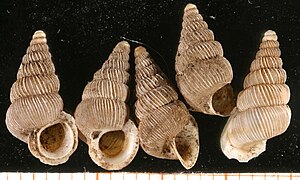Cochlostoma roseoli
| Cochlostoma roseoli | ||||||||||||
|---|---|---|---|---|---|---|---|---|---|---|---|---|

Cochlostoma roseoli |
||||||||||||
| Systematics | ||||||||||||
|
||||||||||||
| Scientific name | ||||||||||||
| Cochlostoma roseoli | ||||||||||||
| ( AJ Wagner , 1901) |
Cochlostoma roseoli , also broad-lipped tower snail, is a land-living snail from the family of forest snails (Cochlostomatidae) in the order Architaenioglossa ("old bandworm").
features
The right-hand wound case is 9 to 12 mm high and 4.5 to 6 mm wide. The apex of the housing is often truncated. It has nine turns; the top two to three turns are empty in adults and are often shed. When present, they are glass-like, shiny and transparent. The surface is covered with strong, sharp and uniform ribs. They are arranged regularly and are quite close together. The slightly crooked but hardly curved ribs are only missing on the embryonic turns, and are a little further on the end turn.
The mouth is very wide and is perpendicular to the winding axis. The thin and sharp tapering and very fragile edge of the mouth is broadly turned outwards and greatly expanded. In the spindle and parietal area it is drawn out in the shape of an ear. The palate area is colored brown.
The basic color of the housing is horn yellow, or purple-brown if the animal has dried out in the housing. The ribs and the thin, fragile edge of the mouth are colored matt yellow-white.
The slightly concave operculum consists of a horn-like plate with a thin calcified surface on the outside. The surface appears grained and matt. The edition is thickened like a strip. The turns of the operculum are thus well marked, the ridges are finely striped radially.
Geographical distribution and habitat
The distribution area of the species extends from Herzegovina via Montenegro to northern Albania . The animals live there in open habitats on chalky subsoil.
Taxonomy
The taxon was first described in 1901 by Anton Josef Wagner under the name Pomatias (Pleuropoma) roseoli . The type material comes from Avtovac ( Gacko , Herzegovina). Today it is referred to as Cochlostoma (Holcopoma) roseoli (A. Wagner, 1901).
The species is currently divided into six subspecies:
- Cochlostoma (Holcopoma) roseoli kiriense (AJ Wagner, 1906)
- Cochlostoma (Holcopoma) roseoli prekalense (Polinski, 1924)
- Cochlostoma (Holcopoma) roseoli rioliense (AJ Wagner, 1914)
- Cochlostoma (Holcopoma) roseoli roseoli (AJ Wagner, 1901)
- Cochlostoma (Holcopoma) roseoli scutariense (AJ Wagner, 1906)
supporting documents
literature
- Rosina Fechter and Gerhard Falkner: molluscs. 287 pp., Mosaik-Verlag, Munich 1990 (Steinbach's Nature Guide 10) ISBN 3-570-03414-3
- Francisco W. Welter-Schultes: European non-marine molluscs, a guide for species identification = identification book for European land and freshwater mollusks. A1-A3 S., 679 S., Q1-Q78 S., Göttingen, Planet Poster Ed., 2012 ISBN 3-933922-75-5 , ISBN 978-3-933922-75-5
Individual evidence
- ^ Fechter & Falkner (1990: p. 116)
- ^ Anton Josef Wagner: New forms and locations of the genus Pomatias Studer. Annals of the Imperial and Royal Natural History Museum, 16 (Notes): 63-65, Vienna 1901 Online at www.biodiversitylibrary.org (p. 64).
- ↑ a b Fauna Europaea - Cochlostoma (Holcopoma) roseoli (AJ Wagner, 1901)
On-line
Web links
- Cochlostoma roseoli inthe IUCN 2013 Red List of Threatened Species . Posted by: Feher, Z., 2011. Retrieved February 14, 2014.